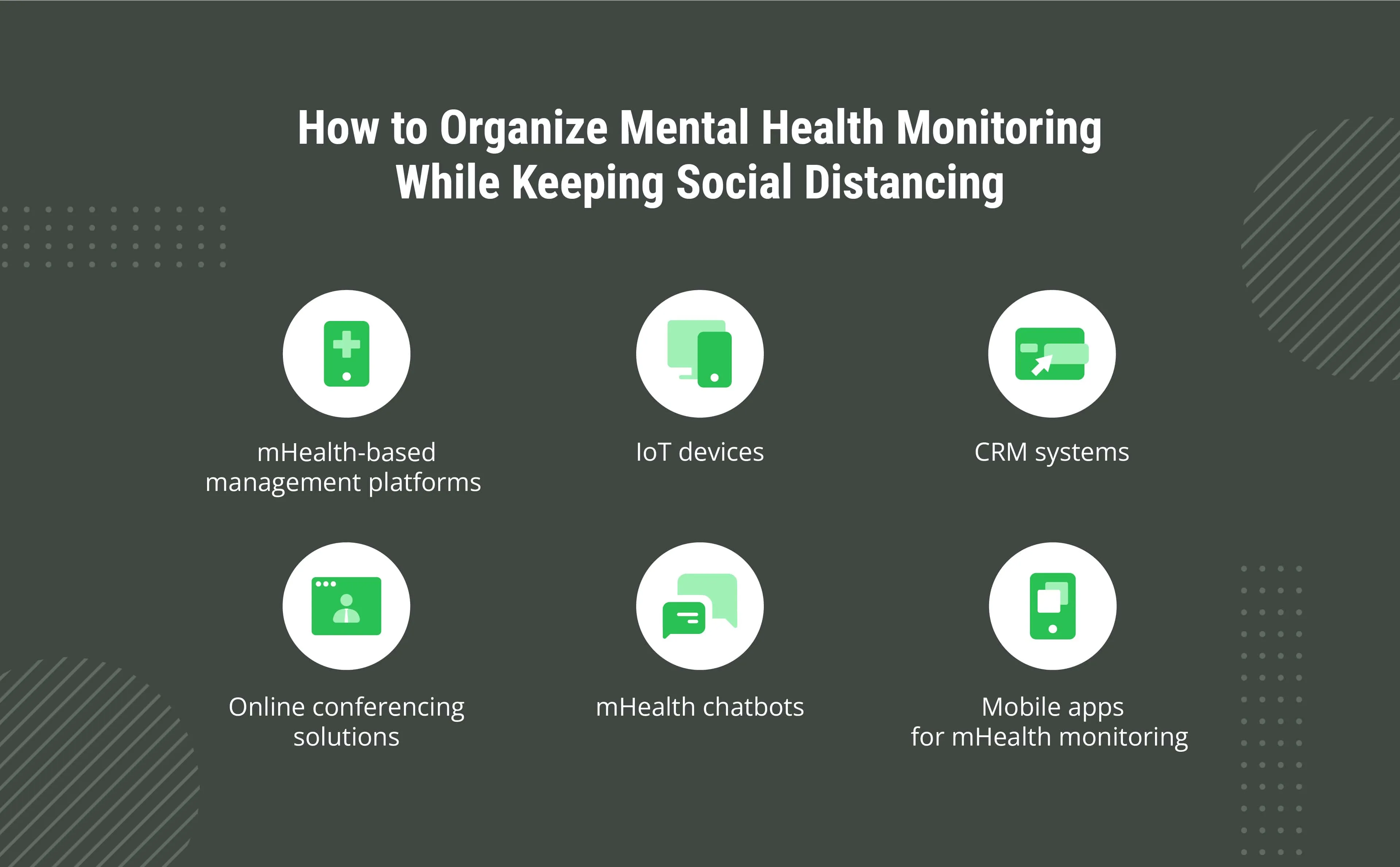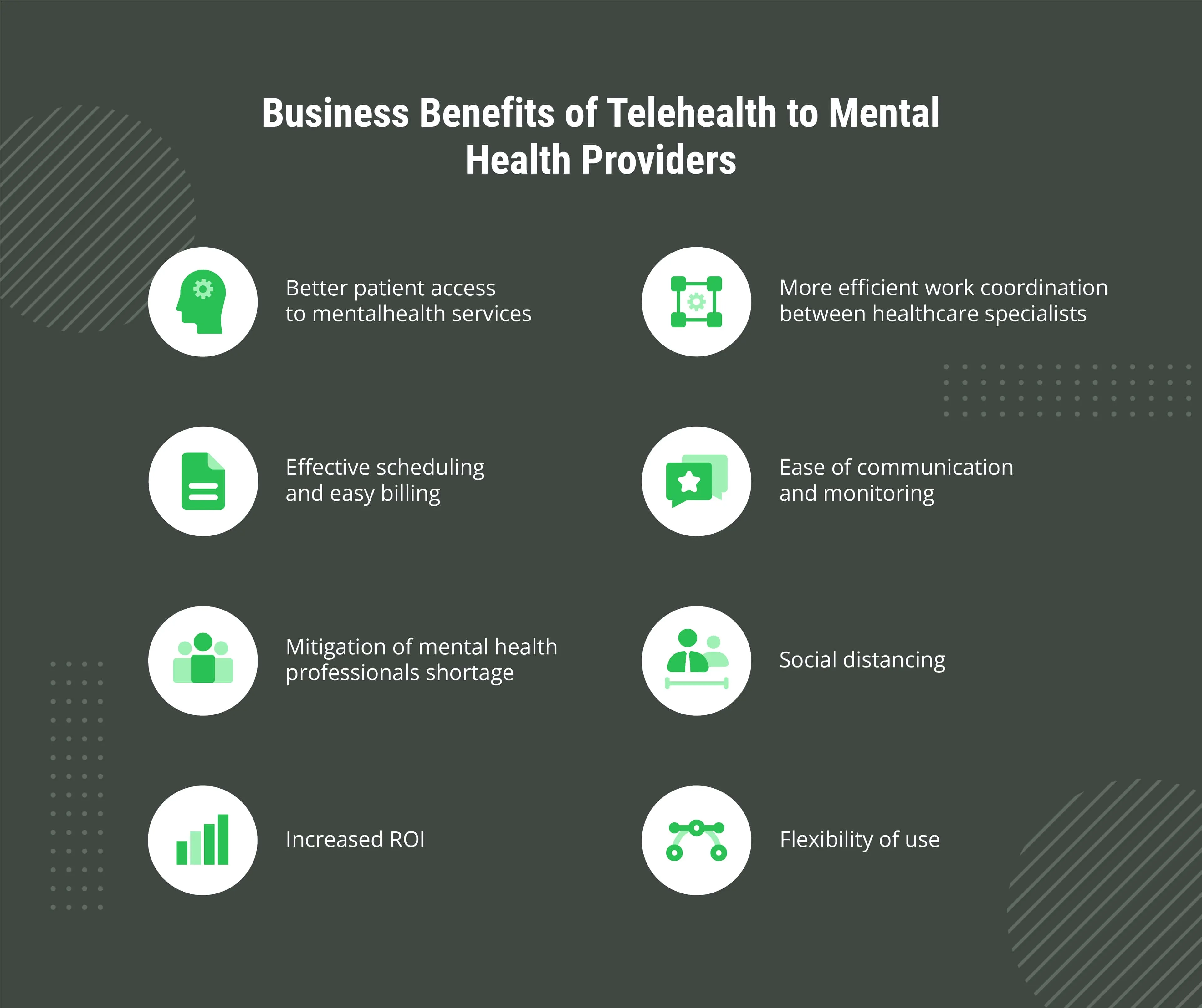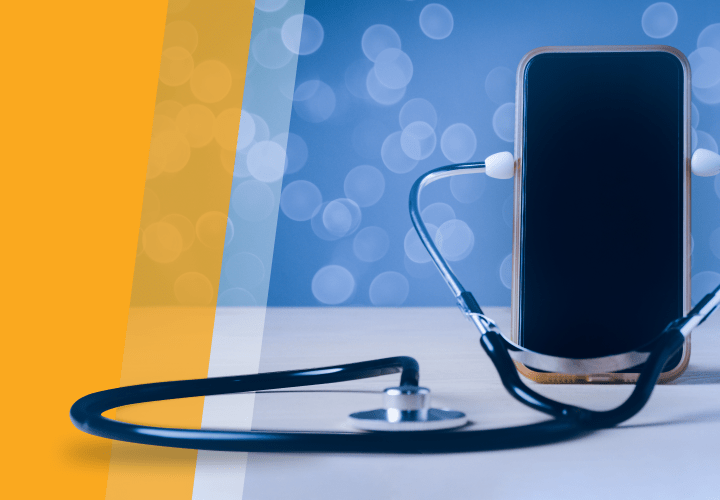How to Use Telehealth for Mental Health Monitoring
Table of contents
- Why Does Mental Telehealth Matter?
- How To Organize Mental Health Monitoring While Social Distancing?
- mHealth-based management platforms
- IoT devices
- CRM systems
- Online conferencing solutions
- mHealth chatbots
- Mobile apps for mHealth monitoring
- Benefits of Telebehavioral Health, Telepsychiatry, and Telepsychology to Mental Health Organizations
- Better patient access to mental health services
- More efficient work coordination between healthcare specialists
- Effective scheduling and easy billing
- Ease of communication and monitoring
- Mitigation of mental health professionals shortage
- Increased ROI
- Flexibility of use
- The Bottom Line
Telemental health, which can also be referred to as telebehavioral health, telepsychiatry, or telepsychology, has increased in popularity during the COVID-19 pandemic, and for good reasons. It does not just benefit patients who can now access care from the privacy and safety of their homes but also unlocks great potential for mental health providers.
So let's dive into the phenomenon of telemental health to learn why it matters, how it can be used in today’s environment, and why this model of mental care provision will soon become a new normal.
Why Does Mental Telehealth Matter?
As the World Health Organization stated in their report on mental disorders, 1 in 4 people across the world will face a mental or neurological disorder at some point throughout their life. More significant data provided by Mental Health America shows that before the pandemic started, 19.86% of adults experienced a mental illness, equivalent to nearly 50 million Americans. After the coronavirus outbreak, the situation has even worsened.
The thing is that we, human beings, are social creatures in nature. So isolation measures that were taken worldwide after the COVID-19 outbreak negatively affected our mental well-being. While it is true that people’s reactions to isolation measures vary from one person to another, there are some that became typical for many of us. These include:
- An increased feeling of loneliness due to decreased social interactions;
- Lowerings in motivation caused by irregular daily schedule;
- Changes in appetite;
- Lack of focus and concentration;
- Impaired sleep;
- Increase in such feelings as sadness, uncertainty, fear, anxiety, anger, frustration, irritability, numbness;
- Growth in alcohol, nicotine, and drugs consumption.
And while such reactions are normal to such an abnormal situation, previously used approaches to monitoring patients with mental health issues required drastic changes due to the quarantine and isolation measures. For this reason, the tech market saw an increased demand for mental health app development.
One more good reason for the adoption of mental telehealth solutions is the fact that in rural areas, access to mental health care is not easy, and telehealth becomes a perfect solution that allows the provision of care to everyone.
How To Organize Mental Health Monitoring While Social Distancing?
As you can see, one of the crucial challenges that occur with the COVID-19 outbreak is related to social distancing measures that were implemented for health safety reasons. And while psychological therapy implies direct contact with patients that allows healthcare providers to effectively monitor changes in behavior, mood, and other crucial to mental status factors, telemental health solutions should provide the same opportunities for monitoring as in the traditional methods of care. And there are good alternatives.

mHealth-based management platforms
MHealth management platforms can help tackle mental illness in a scalable and cost-efficient way by enabling early intervention and treatment. Such solutions have friendly scheduling tools, client portals, progress notes, custom treatment plans, online chats, and video sessions, custom questionnaires, billing and invoicing options, and other good things mHealth systems have on offer. When used for mental health care, such solutions contribute to the reduction of no-shows, which positively impact both the work of a specialist and the progress of a patient.
IoT devices
IoT devices are often wearables, such as wristwear, clothing, belts, and body patches, containing sensors to measure physical activity and heart rate variability. The sensor data from the wearables may be combined with other data sources and used to classify emotional reactions, mood states, and stress in various psychiatric disorders. For example, IoT devices are used for bipolar disorder identification: activity patterns allow distinguishing bipolar disorder from other diagnoses, and heart rate variability allows predicting mood state.
CRM systems
CRM systems used for mental health practitioners are aimed at improving the overall therapy sessions management, reducing administrative work, and providing high safety standards. Also, such systems allow consolidating the work of different departments, in this way contributing to a more efficient and effective practice.
Online conferencing solutions
In recent years, video conferencing tools have become a new normal in the healthcare industry, with mental health providers being no exception. Online consultations with the use of quality technology make it possible for providers to access patients who can’t visit their offices, handle effective communication, monitor changes in patients’ mood and behavior. In other words, it’s exactly video conferencing tools that make it possible to shift from personal visits to a clinic to an online model of mental health service provision.
mHealth chatbots
The digital mental health care industry has recently begun to incorporate AI into existing platforms and create various AI-guided products. Some of the most popular use cases of AI in mental healthcare include chatbots for communication, virtual reality, symptom and biomarker monitoring, and personalization of content. With AI chatbots for healthcare, also known as conversational agents or relational agents, a user can hold a conversation with smart technology to get the needed support, guidance, pre-diagnostics, and so on. Such solutions become extremely helpful for the provision of 24/7 support, as well as in cases of work overload, so a patient can learn some info from a chatbot instead of contacting a professional.
Mobile apps for mHealth monitoring
For sure, one of the most popular, convenient, and demanded types of technological solutions used for mental health management are represented by mobile apps. Such apps incorporate proven techniques such as Cognitive Behavioral Therapy (CBT) and Acceptance Commitment Therapy (ACT) and address everything from depression to eating disorder recovery, anxiety, PTSD, obsessive-compulsive disorder, and more.
Among them are also symptom trackers that work based on the same principle as a migraine prevention app developed by Emerline. They allow patients to monitor their swings in mood, get a better understanding of what has an impact on their mental well-being, allow making predictions, and provide useful recommendations.
Benefits of Telebehavioral Health, Telepsychiatry, and Telepsychology to Mental Health Organizations
While the benefits of telehealth solutions to patients are widely discussed and known, there are also significant advantages mental health providers can reap out of leveraging technology into their organizations.

Better patient access to mental health services
Telehealth services imply that patients and healthcare providers don’t have to be in a similar location. So in cases when patients can’t transport themselves, live too far from the office, or face other issues preventing them from visiting a mental health specialist, these virtual meetings can have an immense effect. One of the key benefits for providers that derive from visual sessions is the reduction of patients’ no-shows.
More efficient work coordination between healthcare specialists
With telehealth used for mental health care, coordination between professionals has become easier than ever. Access to a database where important information about a patient’s treatment plan, progress, and history, allows being more accurate with diagnostics and more effective with treatment planning.
Effective scheduling and easy billing
Modern telehealth systems are designed to offer the benefit of seamless integration of all issues related to the provision of mental health care, whether it is appointments scheduling, medical bill payment, prescriptions, etc. Everything is given in the all-in-one telehealth experience.
Ease of communication and monitoring
Communication and monitoring in a telehealth model are achieved with the use of technology, which makes it easier and more convenient for mental health professionals to communicate, monitor, and follow up with their patients in real-time.
Mental health professionals can provide their patients with various important materials, including appointment reminders, coping techniques, mental health resources, etc. What’s more, telehealth also allows symptom monitoring through remote patient sensors and telemedicine apps. And the virtual landscape makes it easier to follow-up with patients and provide treatment.
Mitigation of mental health professionals shortage
Unfortunately, there is a lack of mental health professionals for millions of people who require mental care. And telehealth is a wonderful option that allows minimizing this gap because it only requires a stable internet connection and a laptop, computer, tablet, or smartphone with a camera. The simplicity of telehealth allows mental health professionals to access their patients regardless of location. Telehealth allows mental health professionals to provide services in areas that otherwise would not have access to their care and resources.
Increased ROI
For providers, integrating this lucrative technology presents some significant returns on investment. Used with an emergency department, telepsychiatry can provide more efficient connectivity with outpatient mental health services. This can help to close referral loops between ER and other departments.
In primary care and specialty care clinics, telepsychiatry could provide significant cost savings to medical groups while improving the health status of patients. Telepsychiatry may also reduce costs in correctional facilities and nursing homes, including transportation, labor, and general care-oriented factors.
Flexibility of use
Telemental health naturally incorporates greater flexibility that can be applied to nearly all medical departments. It could help to bring more quality care to emergency rooms where generally there is no personnel or equipment to assess or treat those with mental health issues. In nursing homes, mental telehealth can be applied as a means of providing ongoing psychiatric care and evaluation
The Bottom Line
The adoption of telehealth during the pandemic has been lightning fast when compared to before the crisis. Telehealth for mental health offers a great avenue to not only sustain mental and behavioral health services but also to expand them greatly during the pandemic.
So if there is a right time to implement telehealth services for mental health, it is now.
If you want to create a telehealth solution for mental health or need any help at implementing a new telehealth platform, feel free to contact our healthcare software development specialists.
Updated on Apr 21, 2025





